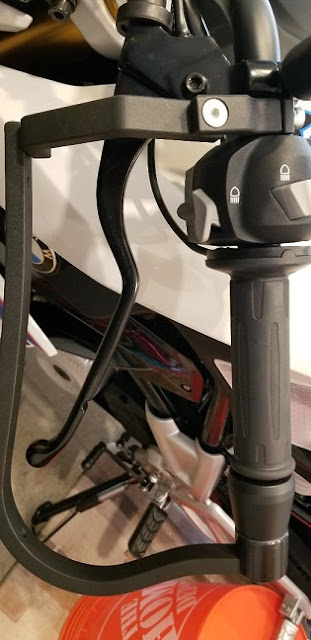Well, my pride denied the possibility of me dropping my bike, but it happened anyway. My bike fell over. Fortunately, the protection gear I added (Barkbusters and Crash Bars) did their job. But, despite all of the tips and techniques shown on YouTube, my 71 year old body could not lift the bike.
Help, I've fallen and I can't get up!!!
I dropped the bike when trying to place it on the center stand. Instead of holding the handlebars, I grabbed the crash bar. This allowed the front tire to turn and down she went.
My wife helped me and we struggled to get the bike up and on the stand.
Since I often ride alone, I thought: "What would I do if I was alone somewhere with nobody to help?"
I researched solutions and found three: Motobike Jack, Dirt Napper and MotoWinch.
All three jacks looked like good solutions. My favorite was the MotoWinch. Alas, in this crazy supply shortage, neither the MotoWinch or Dirt Napper were in stock. I seriously considered the MotoBike Jack available from Ray Lyons direct or thru Amazon. But, I saw some shortcomings in all of the designs.
First, they were all a bit "short" in that they probably would not lift my bike up completely---I would have to finish the job by pushing the bike up the final 15-30 degrees. Second, they all used a modified ratchet strap mechanism.
So, I decided to make my own.
First, I repurposed the ram extensions from a porta-power. This gave me 34 inches of length in the bar. I then fabricated another 18 inch length using 1/2" steel pipe, a 5/8" bolt and a heavy duty clevis yoke. This gave me 52 inches of length--enough to lift the bike fully upright. (The effective lifting distance is 43 inches, after accounting for the hoist or ratchet--almost enough to lift the G310R fully upright.)
The lift will essentially be at a 40-42 degree angle when the bike is upright, so if engaged at the lowest part of the seat, the 43 inch lift brings the bike fully upright. In addition, the longer the bar, the less the lift leans as the bike is lifted--making it easier to keep the "foot" in place.
The main "disadvantage" of the commercial offerings is that they do not typically lift the bike fully upright. First, a column becomes much weaker as it gets longer, so limiting the maximum length saves weight and space. Second, a ratchet strap is severely limited as to distance of lift, depending on the thickness of the strap. Most straps will only allow about 20 inches of lift. In essence, the commercial offerings lift the bike to a point that requires the rider to lift the bike the final 30 degrees. This can still be a force required in excess of 100 pounds. However, the rider is better positioned to apply such force using only leg muscles. But for a senior rider with bad knees or hips, that force could still be intimidating. And then, there is the possibility that the bike falls on a surface that is not horizontal, but downward sloping, which requires more lifting distance.
A fabricated a ratchet strap winch to hook to the bar. (Took the ratchet apart so that it pulled down when rolling the strap.) But, my real desire was to use the 1/4 ton reversable chain hoist from Harbor Freight---this allowed me to raise or lower the bike.










































